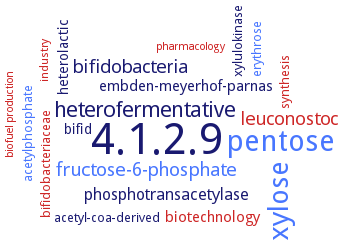4.1.2.9: phosphoketolase
This is an abbreviated version!
For detailed information about phosphoketolase, go to the full flat file.

Word Map on EC 4.1.2.9 
-
4.1.2.9
-
pentose
-
xylose
-
heterofermentative
-
fructose-6-phosphate
-
leuconostoc
-
bifidobacteria
-
phosphotransacetylase
-
biotechnology
-
embden-meyerhof-parnas
-
heterolactic
-
bifid
-
synthesis
-
xylulokinase
-
acetylphosphate
-
erythrose
-
acetyl-coa-derived
-
bifidobacteriaceae
-
industry
-
pharmacology
-
biofuel production
- 4.1.2.9
- pentose
- xylose
-
heterofermentative
- fructose-6-phosphate
- leuconostoc
-
bifidobacteria
- phosphotransacetylase
- biotechnology
-
embden-meyerhof-parnas
-
heterolactic
-
bifid
- synthesis
- xylulokinase
- acetylphosphate
- erythrose
-
acetyl-coa-derived
- bifidobacteriaceae
- industry
- pharmacology
- biofuel production
Reaction
Synonyms
CAC1343, D-xylulose 5-phosphate phosphoketolase, D-Xylulose-5-phosphate D-glyceraldehyde-3-phosphate-lyase, D-Xylulose-5-phosphate phosphoketolase, FXPK, Pentulose-5-phosphate phosphoketolase, PhK, phosphoketolase, phosphoketolase-1, phosphoketolase-2, PKT, Pu5PPK, slr0453, X5P/F6P phosphoketolase, X5PPK, Xfp, XFPK, XPK, XpkA, xylulose-5-phosphate phosphoketolase, xylulose-5-phosphate/fructose-6-phosphate phosphoketolase
ECTree
Advanced search results
Cloned
Cloned on EC 4.1.2.9 - phosphoketolase
Please wait a moment until all data is loaded. This message will disappear when all data is loaded.
cloned in a prokaryotic vector, and the encoded protein is expressed in Escherichia coli
installation of a functional phosphoketolase pathway in xylose-fermenting Saccharomyces cerevisiae strain TMB3001c by heterologous expression of phosphotransacetylase and acetaldehyde dehydrogenase in combination with the native phosphoketolase
-
into the vector pET21a+ for expression in Escherichia coli BL21DE3 cells
into the vectors pET21a+ and pET28b+ for expression in Escherichia coli BL21DE3 cells
overexpression of the Bifidobacterium animalis xfp gene (encoding a phosphoketolase with dual substrate specificity) in a Corynebacterium glutamicum strain that is previously engineered to overproduce L-glutamic acid results in a 14% increase in the L-Glu yield from glucose
Saccharomyces cerevisiae does not demonstrate efficient phosphoketolase activity naturally. When phosphoketolase fome is expressed in Saccharomyces cerevisiae significant amounts of acetyl-phosphate are produced after provision of sugar phosphate substrates in vitro. Expression of bacterial phosphoketolase in Saccharomyces cerevisiae can efficiently divert intracellular carbon flux toward C2-synthesis, thus showing potential to be used in metabolic engineering strategies aimed to increase yields of acetyl-CoA derived compounds
Saccharomyces cerevisiae does not demonstrate efficient phosphoketolase activity naturally. When phosphoketolase is expressed in Saccharomyces cerevisiae significant amounts of acetyl-phosphate are produced after provision of sugar phosphate substrates in vitro. Expression of bacterial phosphoketolase in Saccharomyces cerevisiae can efficiently divert intracellular carbon flux toward C2-synthesis, thus showing potential to be used in metabolic engineering strategies aimed to increase yields of acetyl-CoA derived compounds
Saccharomyces cerevisiae does not demonstrate efficient phosphoketolase activity naturally. When the phosphoketolase is expressed in Saccharomyces cerevisiae significant amounts of acetyl-phosphate are produced after provision of sugar phosphate substrates in vitro. Expression of bacterial phosphoketolase in Saccharomyces cerevisiae can efficiently divert intracellular carbon flux toward C2-synthesis, thus showing potential to be used in metabolic engineering strategies aimed to increase yields of acetyl-CoA derived compounds
-
cloned in a prokaryotic vector, and the encoded protein is expressed in Escherichia coli
cloned in a prokaryotic vector, and the encoded protein is expressed in Escherichia coli
Saccharomyces cerevisiae does not demonstrate efficient phosphoketolase activity naturally. When phosphoketolase fome is expressed in Saccharomyces cerevisiae significant amounts of acetyl-phosphate are produced after provision of sugar phosphate substrates in vitro. Expression of bacterial phosphoketolase in Saccharomyces cerevisiae can efficiently divert intracellular carbon flux toward C2-synthesis, thus showing potential to be used in metabolic engineering strategies aimed to increase yields of acetyl-CoA derived compounds

Saccharomyces cerevisiae does not demonstrate efficient phosphoketolase activity naturally. When phosphoketolase fome is expressed in Saccharomyces cerevisiae significant amounts of acetyl-phosphate are produced after provision of sugar phosphate substrates in vitro. Expression of bacterial phosphoketolase in Saccharomyces cerevisiae can efficiently divert intracellular carbon flux toward C2-synthesis, thus showing potential to be used in metabolic engineering strategies aimed to increase yields of acetyl-CoA derived compounds
KRU18827.1, KRU19755.1
Saccharomyces cerevisiae does not demonstrate efficient phosphoketolase activity naturally. When phosphoketolase is expressed in Saccharomyces cerevisiae significant amounts of acetyl-phosphate are produced after provision of sugar phosphate substrates in vitro. Expression of bacterial phosphoketolase in Saccharomyces cerevisiae can efficiently divert intracellular carbon flux toward C2-synthesis, thus showing potential to be used in metabolic engineering strategies aimed to increase yields of acetyl-CoA derived compounds

AJD88698.1
Saccharomyces cerevisiae does not demonstrate efficient phosphoketolase activity naturally. When phosphoketolase is expressed in Saccharomyces cerevisiae significant amounts of acetyl-phosphate are produced after provision of sugar phosphate substrates in vitro. Expression of bacterial phosphoketolase in Saccharomyces cerevisiae can efficiently divert intracellular carbon flux toward C2-synthesis, thus showing potential to be used in metabolic engineering strategies aimed to increase yields of acetyl-CoA derived compounds
KHD36088.1
Saccharomyces cerevisiae does not demonstrate efficient phosphoketolase activity naturally. When phosphoketolase is expressed in Saccharomyces cerevisiae significant amounts of acetyl-phosphate are produced after provision of sugar phosphate substrates in vitro. Expression of bacterial phosphoketolase in Saccharomyces cerevisiae can efficiently divert intracellular carbon flux toward C2-synthesis, thus showing potential to be used in metabolic engineering strategies aimed to increase yields of acetyl-CoA derived compounds
KRU18827.1, KRU19755.1
Saccharomyces cerevisiae does not demonstrate efficient phosphoketolase activity naturally. When phosphoketolase is expressed in Saccharomyces cerevisiae significant amounts of acetyl-phosphate are produced after provision of sugar phosphate substrates in vitro. Expression of bacterial phosphoketolase in Saccharomyces cerevisiae can efficiently divert intracellular carbon flux toward C2-synthesis, thus showing potential to be used in metabolic engineering strategies aimed to increase yields of acetyl-CoA derived compounds


 results (
results ( results (
results ( top
top





